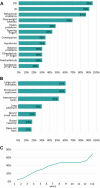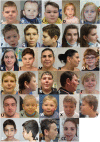PHIP-associated Chung-Jansen syndrome: Report of 23 new individuals
- PMID: 36726590
- PMCID: PMC9886139
- DOI: 10.3389/fcell.2022.1020609
PHIP-associated Chung-Jansen syndrome: Report of 23 new individuals
Abstract
In 2016 and 2018, Chung, Jansen and others described a new syndrome caused by haploinsufficiency of PHIP (pleckstrin homology domain interacting protein, OMIM *612,870) and mainly characterized by developmental delay (DD), learning difficulties/intellectual disability (ID), behavioral abnormalities, facial dysmorphism and obesity (CHUJANS, OMIM #617991). So far, PHIP alterations appear to be a rare cause of DD/ID. "Omics" technologies such as exome sequencing or array analyses have led to the identification of distinct types of alterations of PHIP, including, truncating variants, missense substitutions, splice variants and large deletions encompassing portions of the gene or the entire gene as well as adjacent genomic regions. We collected clinical and genetic data of 23 individuals with PHIP-associated Chung-Jansen syndrome (CHUJANS) from all over Europe. Follow-up investigations (e.g. Sanger sequencing, qPCR or Fluorescence-in-situ-Hybridization) and segregation analysis showed either de novo occurrence or inheritance from an also (mildly) affected parent. In accordance with previously described patients, almost all individuals reported here show developmental delay (22/23), learning disability or ID (22/23), behavioral abnormalities (20/23), weight problems (13/23) and characteristic craniofacial features (i.e. large ears/earlobes, prominent eyebrows, anteverted nares and long philtrum (23/23)). To further investigate the facial gestalt of individuals with CHUJANS, we performed facial analysis using the GestaltMatcher approach. By this, we could establish that PHIP patients are indistinguishable based on the type of PHIP alteration (e.g. missense, loss-of-function, splice site) but show a significant difference to the average face of healthy individuals as well as to individuals with Prader-Willi syndrome (PWS, OMIM #176270) or with a CUL4B-alteration (Intellectual developmental disorder, X-linked, syndromic, Cabezas type, OMIM #300354). Our findings expand the mutational and clinical spectrum of CHUJANS. We discuss the molecular and clinical features in comparison to the published individuals. The fact that some variants were inherited from a mildly affected parent further illustrates the variability of the associated phenotype and outlines the importance of a thorough clinical evaluation combined with genetic analyses for accurate diagnosis and counselling.
Keywords: CHUJANS; CUL4B; Chung-Jansen syndrome; DD; DIDOD syndrome; ID; PHIP; obesity.
Copyright © 2023 Kampmeier, Leitão, Parenti, Beygo, Depienne, Bramswig, Hsieh, Afenjar, Beck-Wödl, Grasshoff, Haack, Bijlsma, Ruivenkamp, Lausberg, Elbracht, Haanpää, Koillinen, Heinrich, Rost, Jamra, Popp, Koch-Hogrebe, Rostasy, López-González, Sanchez-Soler, Macedo, Schmetz, Steinborn, Weidensee, Lesmann, Marbach, Caro, Schaaf, Krawitz, Wieczorek, Kaiser and Kuechler.
Conflict of interest statement
The authors declare that the research was conducted in the absence of any commercial or financial relationships that could be construed as a potential conflict of interest.
Figures





References
-
- Becker K., Di Donato N., Holder-Espinasse M., Andrieux J., Cuisset J. M., Vallée L., et al. (2012). De novo microdeletions of chromosome 6q14.1-q14.3 and 6q12.1-q14.1 in two patients with intellectual disability - further delineation of the 6q14 microdeletion syndrome and review of the literature. Eur. J. Med. Genet. 55, 490–497. 10.1016/j.ejmg.2012.03.003 - DOI - PubMed
-
- Cabezas D. A., Slaugh R., Abidi F., Arena J. F., Stevenson R. E., Schwartz C. E., et al. (2000). A new X linked mental retardation (XLMR) syndrome with short stature, small testes, muscle wasting, and tremor localises to Xq24-q25. J. Med. Genet. 37, 663–668. 10.1136/jmg.37.9.663 - DOI - PMC - PubMed
LinkOut - more resources
Full Text Sources
Miscellaneous

